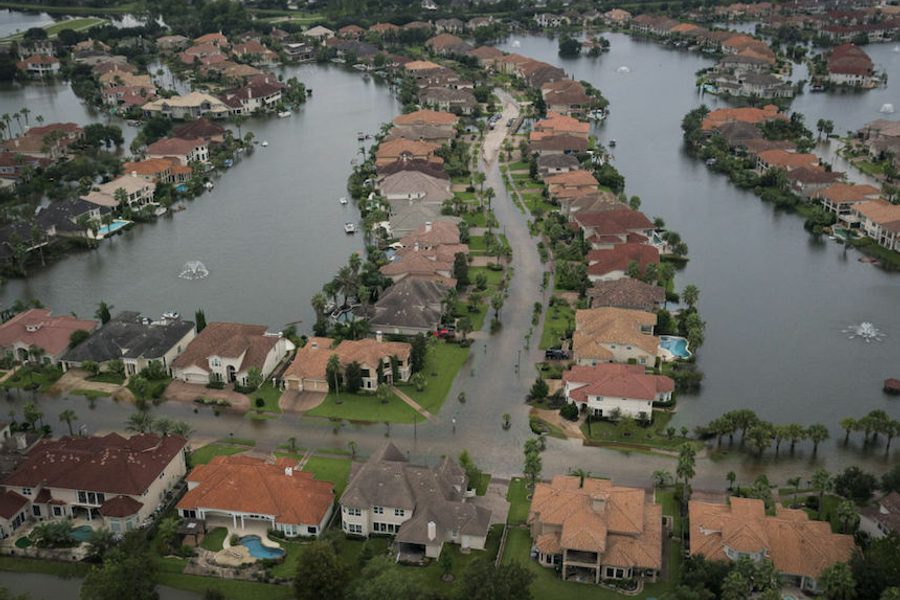How Bad Politics and Bad Planning Make Hurricanes Even Worse
To prepare for the impacts of climate change, other cities must learn the lessons of Hurricane Harvey.
Ashley Dawson

Hurricane Harvey was an unnatural disaster. Contrary to much media coverage, the devastation of Houston and surrounding areas resulted not so much from an isolated extreme weather event, although Hurricane Harvey was indeed the biggest recorded rainstorm ever to hit the contiguous United States. Rather, the flooding is the product of a combination of anthropogenic climate change, rampant real estate speculation, political corruption and the toxic blend of fossil fuel addiction and climate change denial that characterizes the Trump administration and its supporters. In the wake of Hurricane Irma’s impact on Florida and the Caribbean, and the other hurricanes to have hit since Harvey, it is past time to begin a national conversation about strategic retreat from imperiled cities like Houston, and about the measures that would be necessary to make this a just retreat. To gain a better sense of the stakes of such a conversation, we first need to understand the particular perils facing Houston and other coastal cities.
Houston is hardly alone as a coastal city facing multiple climate change-related perils. Globalization has helped accelerate the growth of coastal megacities in the United States and around the world. We usually think of globalization in terms of jet airplanes, but in fact the container ship is the most important vehicle of contemporary international exchange. Consequently, port cities like Houston (and Guangzhou, Nagoya and Mumbai, among others) have grown explosively in recent decades. The wave of planetary urbanization along the coasts has been particularly dramatic in sub-Saharan Africa and Asia, where changing economic prospects have led migrants to settle in vast slums in the hearts of cities like Lagos, Nigeria and Dhaka, Bangladesh. But neoliberal globalization has helped produce increasing economic polarization even in relatively affluent cities like New York, Miami and Houston, the latter of which, according to a study by the Pew Research Center, has the most dramatic income segregation of the nation’s 10 largest cities. Such extreme socio-economic inequality and segregation weakens social and political cohesion, making it far less likely that cities will develop adaptation strategies adequate to ensure the safety of all their citizens in the face of storms like Harvey.
These extreme cities are sorely in need of canny adaptive strategies. In 2013, a study led by World Bank economist Stephane Hallegatte warned that climate change, rapid urbanization and subsiding land are placing the world’s coastal cities at increasing risk of dangerous and costly flooding, and that half of the 10 most at-risk cities in terms of overall cost of damage are in the United States. In terms of sheer numbers of vulnerable people, though, cities in poor countries„ like Abidjan, Ivory Coast, and Dhaka, may be the most imperiled.
How We Got Here
Climate change is bringing fiercer and more frequent storms to cities around the globe. A recent study by a group of climate scientists based at Princeton and Rutgers projected a forty-fold increase in the number of 100-year floods along the U.S. coastline by 2050. Some of this increased flood risk is a result of rising sea levels, which make the storm surges pushed by powerful hurricanes like Harvey higher and more deadly. But, as Harvey demonstrated, climate change also makes the rainfall that accompanies big storms worse: Since warmer air holds more water vapor, climate change is causing more intense rainfall and snowstorms. This link between warmer air and increased precipitation is particularly noticeable in cities. As a result of the urban heat island effect, which is produced when natural surfaces like vegetation and water are replaced by heat-trapping concrete and asphalt, large cities are expected to warm an additional two degrees compared to non-urban areas by 2050, a recent study found. Cities are effectively creating their own extreme weather patterns.
Bad planning decisions made by urban authorities can significantly aggravate the destructive impact of the extreme weather events linked to climate change. Houston is a particularly clear and tragic case of an unjustified failure to prepare. Harvey may have dumped massive amounts of rain on the city, but it didn’t come out of the blue: It is the third 500-year flood the city has experienced in the last three years. The previous two — the Memorial Day 2015 and the Tax Day 2016 floods — together killed 16 people and caused more than $1 billion in damage. Houston has seen the most damaging flooding of any city in the country in recent decades, according to Texas A&M scientist Sam Brody. Harvey’s most direct precedent is Tropical Storm Allison, which swamped the city with nearly 40 inches of rainfall in 5 days in 2001, killing 22 people and flooding 73,000 homes.
After Allison, the city and its flood control authority, the Harris County Flood Control District, spent hundreds of millions of dollars to prepare for the next storm, widening the bayous that provide drainage for the city and building detention ponds to temporarily hold floodwater during periods of intense rainfall. FEMA also expanded its floodplain maps — guides to which parts of the city are expected to flood — by up to 20 percent in some parts of the city. Yet, despite these storm-proofing measures, Houston remained highly flood-prone. In fact, the insurance claims Brody used to track the city’s history of flooding spiked dramatically after 2002. What explains this increasing vulnerability to extreme weather?
In a word: sprawl. The explosive growth of low-intensity housing developments in the exurban areas north and west of Houston has stripped the city of much of its natural protection against flooding. According to coastal ecologist Erin Kinney of the Houston Advanced Research Center, bulldozing wetlands is the key contributor to Houston’s flooding. When water-absorbing natural terrain is replaced by cement and asphalt, water becomes “runoff;” Rather than sinking into the ground it moves horizontally toward bayous, streams and, ultimately, the Gulf of Mexico. But first, it floods through people’s homes and cars. Erin Kinney’s work documents the loss of 23,000 acres of freshwater wetland in the Houston-Galveston Bay region between 1953 and 1989 as a result of development and subsidence caused by excessive draining of water from local aquifers. Of what remained, an additional 30 percent was lost between 1992 and 2010, research by Texas A&M scientist John Jacob and his colleagues shows. Part of the problem was that wetlands in the region’s coastal prairie, the area where development was taking place, were not protected by federal conservation guidelines. But in addition, according to a searing account of development in the city published last year by ProPublica and the Texas Tribune, efforts by public officials to prevent development after the 2001 Allison disaster met with stiff resistance and were ultimately stymied by local real estate interests. The money to be made in the short term simply overrode the warnings of scientists and members of the public who worried about the potential for catastrophic flooding.
But not all public officials were anxious to do the right thing. The problem is not simply that Texas has a climate change-denying governor and a state legislature dominated by politicians whose pockets are lined by the oil industry. As the ProPublica/Tribune article documents, Mike Talbott, head of Houston’s flood control authority from 1998 to 2016, rejected research showing that the paving over wetlands with roads and parking lots was a bad idea. He accused scientists whose work demonstrated the dangers of wetlands destruction of being “anti-development.” Talbott long insisted that development has nothing to do with increasing flooding, and stated that the flood control authority had no plans to research the impact of climate change. Rather than challenging development, Talbott and his successor pursued a policy of retrofitting old drainage infrastructure. But in his comments to ProPublica/the Tribune Talbott admitted that these measures wouldn’t come close to protecting the city from another Tax Day flood, let alone a storm like Harvey. To make matters worse, adding all this (relatively ineffective) infrastructure is extremely expensive: Talbott conceded that at the current rate of spending, it would take 400 years to complete his retrofitting plans. While development goes on at a blistering pace, public officials in Houston wait for state and federal officials to make funds available to speed up planned flood infrastructure projects. But as the overflow of the Addicks and Barker reservoirs during Harvey shows, which the Army Corps of Engineers allowed to deluge nearby homes in order to spare downtown Houston from flooding, some infrastructure can actually aggravate flooding under the extreme weather conditions that are becoming the new normal.
Enough False Solutions
The belief that cities can engineer their way out of the problems generated by climate change and development runs deep. And Houston officials are not the only ones to embrace such hopes. Miami Beach, for example, has adopted a resiliency strategy called Rising Above that involves elevating more than 100 miles of roads, building 80 new storm water pumping stations, and raising sea walls in vulnerable areas. Miami Beach Mayor Philip Levine admits that these measures alone will do little more than buy Miami Beach a few short decades before flooding overwhelms the low-lying city. Yet such measures can often generate unforeseen and unjust forms of environmental blowback. Raised roads, for example, can flush storm water into adjacent homes. Elevated sea walls around expensive housing developments push higher levels of flood water into less affluent nearby neighborhoods who lack funding to install such walls. And massive water pumping stations are run on power generated by fossil fuels, so that, indirectly, pumping the water out gradually augments the amount of water coming in. But such big infrastructure projects let public officials trumpet to the media that they are doing something in the face of climate change. Since a significant portion of the funding for infrastructure spending comes from taxes on real estate development, flood infrastructure also gives public officials a golden alibi for greenlighting continued development in their imperiled cities: Without the tax dollars that such development produces, officials can claim, the city would not be able to protect itself from rising tides. Just don’t ask them about the logic of continuing to build luxury condos in flood zones.
This kind of wrongheaded but highly lucrative adaptation to climate change is on display not just in Miami but in cities around the world. With help from Dutch consultants, for example, the Indonesia capital city Jakarta is building a huge sea wall shaped like a mythical bird. The wall is to be covered with elite housing developments where the country’s rich can stash their cash by investing in real estate. But since the city only has one functioning waste treatment plant, the bay formed behind the giant sea wall could become a lagoon of toxic waste. Lagos is building its own version of such a luxury sea wall city, a development to be called Eko Atlantic, which will stand cheek-by-jowl next to some of the city’s worst slums, where hundreds of thousands of poor people eke out an existence without clean water or electricity in a particularly stark version of the climate apartheid that is becoming increasingly widespread.
Houston makes the fundamental hypocrisy of such development particularly plain. After all, the city’s booming real estate market is tied to a significant extent to profits from oil. High prices for oil helped fuel the growth in development that imperiled Houston, while also ironically generating the global warming and the climate change denial that contributed to the city’s devastation. As the greatest center for the petrochemical industry in the United States, Houston exemplifies the deadly contradictions between a fossil fueled economic system based on unfettered economic growth and the environmental sustainability of our great cities.
As in previous unnatural disasters in extreme cities, it is the most vulnerable urban citizens who will suffer the most. Air Alliance Houston has warned that the shutdown of petrochemical plants before Harvey hit Houston put more than 1 million pounds of harmful pollution into the air. Those living closest to these toxic discharges are disproportionately low-income communities of color. The impact of Hurricane Katrina on New Orleans showed that it is precisely such communities that are most devastated during unnatural disasters. And it is not just during floods that these vulnerable communities suffer disproportionately. As the reconstruction of New Orleans following Katrina showed, a process that Naomi Klein dubbed “disaster capitalism,” post-disaster rebuilding can entrench and exacerbate existing inequalities and environmental injustice. After Katrina, public housing was demolished, municipal hospitals were shuttered and the public school system was privatized. It is a truly bitter irony that many of those currently being evacuated from Houston moved to the city after being displaced from New Orleans during and after Katrina.
A just reconstruction of Houston will hinge on steadfast rejection of another round of the neoliberal dogma of privatization. The city cannot aim to rebuild to where it was before Harvey since its pre-disaster state was marked by extreme economic inequality and environmental unsustainability. Reconstruction must instead be based on environmentally sound policies: preserving the city’s remaining green space, curbing development in floodplains and planning for the future impact of climate change, rather than relying on past experience to project the impact of extreme weather to come. The rebuilding effort must also be based on socially just policies, including providing well-paying reconstruction jobs and the skills to carry out those jobs to economically disadvantaged communities in the city.
Plans for a just reconstruction must also consider the question of strategic retreat. After the FEMA flood maps were redrawn in 2001, over 330,000 homes remained in the vulnerable parts of the 100-year floodplain — the area with a 1 percent chance of being flooded in any given year over a 100-year timespan. The residents of these homes were never offered funding to move away from flood zones. Whatever relief funding comes to Houston from the federal and state government following Harvey should be directed first and foremost to people living in such perilous areas so that wealthy residents of the city do not use the lion’s share of relief to fix up their houses, as has happened after many disasters. In addition, residents of neighborhoods in East Houston endangered by the petrochemical industry should be part of the conversation about strategic retreat, and should have emergency relief funds earmarked for them. These communities must be empowered to determine their own course of action so that strategic retreat is not perceived as simply another land grab by gentrifying elites. This was precisely the concern stirred up by plans to remake portions of New Orleans following Katrina, where members of low-income communities feared that plans to shrink the city were part of a much longer history of removing black residents from valuable urban real estate.
The unfolding tragedy in Houston also needs to spark a much broader conversation about our imperiled coastlines and the extreme cities located along them. Less than two weeks before Harvey hit Houston, President Trump signed an executive order revoking Obama-era regulations that required federal infrastructure projects to factor in scientific projections on the effects of climate change. Such spectacularly foolish policymaking and the climate change denial it builds on needs to be seen for what it is: a wickedly corrupt capitulation to powerful moneyed interests like the fossil fuel and development industries that puts hundreds of millions of Americans in the direct path of grievous damage and economic ruination. We must revamp the federal flood insurance policies that have encouraged people to settle along imperiled coastlines. At present, FEMA flood insurance policies disproportionately benefit economic elites since by far the greatest percentage of subsidized insurance goes to homes in affluent counties. But such policy changes must not leave poor communities under water, both economically and literally. We also need to have a frank conversation about whether it makes sense to keep rebuilding cities like Houston, where 500-year floods have become a regular phenomenon. Perhaps it’s time to develop a national plan for relocating people away from vulnerable coastlines en masse. Unlike, for example, the Dutch, we are fortunate enough to have the space to do this. But most of all, the tragic flooding of Houston should catalyze a frank recognition of the fatal contradictions of fossil capitalism. Until and unless we recognize that an economic system based on feckless growth and unstinting carbon emissions is suicidal, we will not be in a position to plan a better future. And we will by consequence face ever more frequent unnatural disasters.






